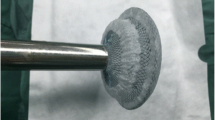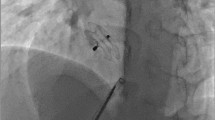Abstract
Fenestrated atrial septal defects (F-ASDs) may pose a challenge to device closure; recently, a cribriform device with a minimal connecting intrawaist diameter and large, equal left- and right-sided discs has been designed to cover more than one adjacent defect. This study demonstrates the feasibility and technical aspects of closing F-ASDs using this new device. Sixteen patients between August 2003 and January 2006 were included in this study. The inclusion criterion was the presence of a F-ASD diagnosed by transesophageal echocardiography. One of the three available cribriform ASD device sizes (18, 25, or 35 mm) was implanted. Patients were followed for at least 1 year after the procedure. Thirteen patients had successful cribriform ASD device implantation (median age and weight, 12.5 years and 36 kg, respectively). Ten patients (62%) had an associated atrial septal aneurysm. The mean procedure time was 75.6 ± 28.5 min and the mean fluoroscopy time 14.8 ± 6.3 min. The RVEDD was significantly reduced, from a mean of 24.2 mm to 21.0 (p < 0.05). One patient developed atrial tachycardia requiring cardioversion during the procedure. There were no embolic events, heart block, or mortality. Complete closure was 10 of 13 (77 %) the next day and 12 of 13 (92%) at 6 and 12 months. We conclude that the cribriform Amplatzer device can be successfully and safely used in patients with F-ASDs. Complete closure may take up to 6 months.


Similar content being viewed by others
References
Adams HP (2004) Patent foramen ovale: paradoxical embolism and paradoxical data. Mayo Clin Proc 79:15–20
Aeschbacher BC, Chatterjee T, Meier B (2000) Transesophageal echocardiography to evaluate success of transcatheter closure of secundum atrial septal defects in adults using the buttoned device. Mayo Clinic Proc 75:913–920
Berdat PA, Chatterjee T, Pfammatter JP, et al. (2000) Surgical management of complications after transcatheter closure of an atrial septal defect or patient foramen ovale. J Thorac Cardiovasc Surg 120:1034–1039
Berger F, Ewert P, Bjornstad PG, et al. (1999) Transcatheter closure as standard treatment for most interartial defects: experience in 200 patients treated with amplatzer septal occluder. Cardiol Young 9:468–473
Berger F, Vogel M, Alexi-Meskishvili V, et al. (1999) Comparison of results and complications of surgical and Amplatzer device closure of atrial septal defects. J Thorac Cardiovasc Surg 118:674–680
Cao Q, Radtke W, Berger F, et al. (2000) Transcatheter closure of multiple atrial septal defects. Initial results and value of two and three dimensional transoesophageal echocardiography. Eur Heart J 21:941–947
Carano N, Hagler DJ, Agnetti A, et al. (2001) Device closure of fenestrated atrial septal defects: use of single Amplatz atrial septal occluder after balloon atrial septostomy to create a single defect. Cath Cardiovasc Interv 52:203–207
Carminati M, Butera G, et al. (2002) Early and late complications associated with transcatheter occlusion of secundum atrial septal defect. J Am Coll Cardiol 39:1061–1065
Carminati M, Giusti S, Hausdorf G, et al. (2000) A European multicentric experience using the CardioSEAL and Starflex double umbrella devices to close interatrial communications holes with the oval fossa. Cardiol Young 10:519–526
Chan KC, Godman MJ, Walsh K, et al. (1999) Transcatheter closure of artial septal defects and interatrial communications with a new self expanding nitinol double disc device (Amplatzer septal occluder): multicentre UK experience. Heart 82:300–306
Chessa M, Carminati M, Butera G, et al. (2002) Early and late complications associated with transcatheter occlusion of secundum atrial septal defect. J Am Coll Cardiol 39:1061–1065
Cowley CG, Lloyd TR, Bove EL, et al. (2001) Comparison of results of closure of secundum atrial septal defect by surgery versus Amplatzer septal occluder. Am J Cardiol 88:589–591
Dhilon R, Josen M, Henien M, et al. (2002) Transcatheter closure of atrial septal defect preserves right ventricular. Heart 87:461–465
Du ZD, Hijazi ZM, Kleinman CS, et al. (2002) Comparison between transcatheter and surgical closure of secundum atrial septal defect in children and adults: results of a multicentre nonrandomized trial. J Am Coll Cardiol 39:1936–1944
Fischer G, Stieh J, Uebing A, et al. (2003) Experience with transcatheter closure of secundum atrial septal defects using the Amplatzer septal occluder: a single center study in 236 consecutive patients. Heart 89:199–204
Fischer G, Kramer HH, et al. (1999) Transcatheter closure of secundum atrial septal defects with the new self centric Amplatzer septal occluder. Eur Heart J 20:541
Formigari R, Di Donato RM, Mazzera E, et al. (2001) Minimally invasive or interventional repair of atrial septal defect in children: experience in 171 cases and comparison with conventional strategies. J Am Coll Cardiol 37:1707–1712
Galal MO, Wobst A, Halees Z, et al. (1994) Peri-operative complications following surgical closure of artial septal defect type II in 232 patients—a baseline study. Eur Heart J 15:1381–1384
Hausdorf G, Kaulitz R, Paul T, et al. (1999) Transcatheter closure of artial septal defect with a new flexible, self-centering device (the STARFlex Occluder). Am J Cardiol 84:1113–1116
Hijazi ZM, Cao Q, Patel HT, et al. (2000) Transesophageal echocardiographic results of catheter closure of atrial septal defect in children and adults using the amplatzer device. Am J Cardiol 85:1387–1390
Kaulitz R, Paul T, Hausdorf G (1998) Extending the limits of transcatheter closure of atrial septal defects with the double umbrella device (CardioSeal). Heart 80:54–59
Lezo JS, Medina A, Pan M, et al. (2000) Transcatheter occlusion of complex atrial septal defects. Cath Cardiovasc Interv 51:33–41
Pedra CA, Fontes-Pedra SR, Esteves CA, et al. (1998) Multiple atrial septal defects and patent ductus arteriosus. Successful outcome using two Amplatzer setal occluders and Gianturco coils. Cath Cardiovasc Diagn 45:257–259
Pedra CA, Pihkala J, Lee K-J, et al. (2000) Transcatheter closure of artial septal defect using the Cardio-seal implant. Heart 84:320–326
Perry YY, Triedman JK, Gauvreau K, et al. (2000) Sudden death in patients after transcatheter device implantation for congenital heart disease. Am J Cardiol 85:992–995
Prieto LR, Foreman CK, Cheatham JP, et al. (1996) Intermediate-term outcome of transcatheter secundum atrial septal defect closure using the Bard clamshell septal umbrella. Am J Cardiol 78:1310–1312
Roa PS, Berger F, Rey C, et al. (2000) Results of transvenous occlusion of secundum atrial septal defects with fourth generation buttoned device: comparison with first, second and third generation devices. International Buttoned Device Trial Group. J Am Coll Cardiol 36:583–592
Rome JJ, Keane JF, Perry SB, et al. (1990) Double-umbrella closure of artial septal defects: initial clinical applications. Circulation 82:751–758
Schenck MH, Sterba R, Foreman CK, et al. (1995) Improvement in noninvasive electrophysiologic findings in children after transcatheter artial septal defect closure. Am J Cardiol 76:695–698
Sub C, Tajik AJ, Seward JB, et al. (1985) Surgical repair of uncomplicated atrial septal defect without “routine” preoperative cardiac catheterization. J Am Coll Cardiol 6:49–54
Szkutnik M, et al. (2004) Transcatheter closure of double atrial septal defects with a single Amplatzer device. Cath Cardiovasc Interv 61(2):237–241
Thanopoulos BD, Laskari CV, Tsousis GS, et al. (1998) Closure of artial septal defects with the Amplatzer occlusion device: preliminary results. J Am Coll Cardiol 31:1110–1116
Thompson JDR, Aburawi EH, Watterson KG, et al. (2002) Surgical and transcatheter (Amplatzer) closure of artial septal defect: a prospective comparison of results and cost. Heart 87:466–469
Visconti KJ, Bichell DP, Jonas RA, et al. (1999) Developmental outcome after surgical versus interventional closure of secundum atrial septal defect in children. Circulation 100 (Suppl):145–150
Wang JK, Tsai SK, Wu MH, Lin MT, Lue HC (2004) Short and intermediate results of transcatheter closure of atrial septal defect with the Amplazer septal occluder. Am Heart J 148:511–517
Zanchetta M, et al. (2005) Catheter closure of perforated secundum atrial septal defect under intracardiac echocardiographic guidance using a single amplatzer device: feasibility of a new method. J Invas Cardiol 17(5):262–265
Author information
Authors and Affiliations
Corresponding author
Rights and permissions
About this article
Cite this article
Numan, M., El Sisi, A., Tofeig, M. et al. Cribriform Amplatzer Device Closure of Fenestrated Atrial Septal Defects: Feasibility and Technical Aspects. Pediatr Cardiol 29, 530–535 (2008). https://doi.org/10.1007/s00246-007-9079-x
Received:
Accepted:
Published:
Issue Date:
DOI: https://doi.org/10.1007/s00246-007-9079-x




